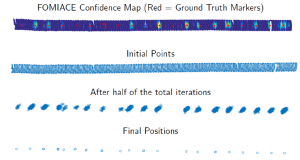
Abstract:
Sensors which use electromagnetic induction (EMI) to excite a response in conducting bodies have been investigated for the purpose of detecting buried explosives. In particular, wide band EMI sensors which use a relatively low number of operating frequencies have been used to discriminate between types of objects, and to detect objects with very low metal content. In this paper, Fourier features are extracted using the 2D Fourier transform from the complex data; both spatially, and across operating frequencies. Then, the Multiple Instance Adaptive Coherence Estimator (MI-ACE) is used to learn cross-validated target signatures from these features. These signatures, as well as learned background, statistics are used with ACE to generate confidence maps, which are clustered into alarms. Alarms are scored against a ground truth and compared to other detection algorithms.
Links:
Citation:
B. Alvey, A. Zare and D. Ho, "Fourier Features for Explosive Hazard Detection using a Wideband Electromagnetic Induction Sensor," in Proc. SPIE 10182, Detection and Sensing of Mines, Explosive Objects, and Obscured Targets XXII, 2017. @InProceedings{Brendan2017Fourier,
Title = {Fourier Features for Explosive Hazard Detection using a Wideband Electromagnetic Induction Sensor},
Author = {Alvey, Brendan and Zare, Alina and Ho, Dominic K. C.},
Booktitle = {Proc. SPIE 10182, Detection and Sensing of Mines, Explosive Objects, and Obscured Targets XXII},
Year = {2017}
}

